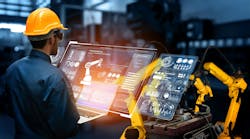Mike Bacidore is the editor in chief for Control Design magazine. He is an award-winning columnist, earning a Gold Regional Award and a Silver National Award from the American Society of Business Publication Editors. Email him at [email protected].
Machine safety has improved exponentially over the past few decades. Automation and technology have played a key role in improving, but there's still work to be done. In December 2014, we conducted an electronic survey to identify usage and application trends of machine safety among the industrial machine builders who read Control Design.
To decide which safety equipment their machines need, 56% of the respondents said they rely on machine builders, 27% said end users choose, and 17% reported that system integrators decide. We also asked about builders' biggest machine safety design headaches, and almost half said it's hard to know which standards and regulations to apply, while 37% said the worst problem is operators trying to defeat the safety system and 14% added that fully operational safety systems impede their productivity.
"Necessity is the mother of invention," says Rick Rice, applications specialist, engineering, at Crest Foods in Ashton, Illinois. "That old adage really has relevance when we are talking about safety and, specifically, machine safety. In the past 20 years, manufacturers have become consciously aware of the fact that, while production is the bottom line, the real resource is the people. Some producers were brought to this realization of their own volition, while others became aware when OSHA succeeded in implementing procedures with fines and penalties for not adhering to this basic right to the protection of life and limb. Regardless of the path to the light side, we are now, more or less, directly impacted by this shift in focus. I dare say that the machine-building industry hasn't been the same since. While the first generation of machine safety primarily involved surrounding the machine in a physical barrier, the second wave has looked to technology to provide inspiration."
See Also: Machine Safety Pays Its Way
Rice remembers the machines of the early 1990s. "Safety was in its infancy, and the quick way to compliance meant putting up a fence and a switch on the door," he recalls. "After a short period of time, machine builders and machine users alike realized that all these barriers made it harder to operate the machines with the same productivity. The human response to this was to disable the barriers or figure out creative ways of overcoming or cheating the system. Unfortunately, this meant dismemberment and, for some poor souls, death. A new initiative must be made to protect the people better without impeding the safe operation of the equipment."
One of the biggest advancements in technology has come in the area of safety, says Rice. "Out of necessity, the industry has come up with ways to make machines safer, while allowing the machines to be not just productive, but more productive," he explains. "The newest initiatives seem to be more directed toward providing better tools for the machine builder to use, in the name of safety. Safety PLCs are one way that safety has gotten easier for the machine builder, but sometimes we can do too much with the safety PLC. I prefer to keep the two systems separate and distinct but link them so that one can't work without the other."
The Crest Foods facility is focused on taking an aging fleet of very capable packaging machinery and giving it new life. "When one undertakes such an adventure, safety takes a major part in the decision-making process," says Rice. "Safety devices can be very scary to our maintenance crew. Some of that comes from just the word ‘safety' itself. People seem to immediately tense up when safety is mentioned. Our approach has been to simplify much of the safety initiative by implementing simple safety devices with as much built-in smarts as possible. Sure, we use all the latest guidelines like Category 3 or 4 capabilities but we keep in mind the folks who will be troubleshooting the safety package when the system won't restart. All of our doors utilize proximity RFID switches unless there is a need to physically ensure the cessation of motion before the doors open. This means no physical parts to get fouled up with powder—believe me, we make a lot of powder. Our switches have two normally closed contacts for the dual-channel safety circuit, but we have a normally open contact for PLC status, as well as indicators on each switch to visually draw the operator to the open door in addition to the message on the HMI. Same goes for our e-stops. Anything we can do to draw the user to the scene of the breach aides our ability to resume production more quickly."
The human attitude needs the most change, says TJ McDermott, project manager at Systems Interface in Seattle. "Companies always say safety is their first priority, so why do people continue to get hurt? Machine guards get bypassed because what is under them needs a lot more attention than the designer intended—jams happen. I'm still not at all convinced that the European method of legislating safety is the right way to go. People still get hurt. At some point, the operators have to be responsible for their own actions and safety." Bypassing a guard for ease of machine use should be grounds for firing and even possibly legal prosecution, he explains.
"As an integrator of robotic systems within packaging lines, we are working through conceptual differences in the risk assessment and grading process between the PMMI standard and the RIA standard," says James Barry, director of engineering at Arpac in Schiller Park, Illinois. "Another area that we are spending time on improvement is our capability to deliver 13849 ‘Performance Level' documentation per customer demands."




